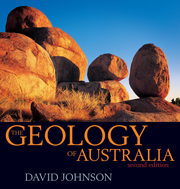Book contents
- Frontmatter
- Contents
- Map
- Preface
- Acknowledgements
- Map of main localities mentioned
- Abbreviations and units
- 1 An Australian perspective
- 2 The Earth: A geology primer
- 3 Building the core of Precambrian rocks
- 4 Warm times: Tropical corals and arid lands
- 5 Icehouse: Carboniferous and Permian glaciation
- 6 Mesozoic warming: The great inland plains and seas
- 7 Birth of modern Australia: Flowering plants, mammals and deserts
- 8 The history and evolution of life on Earth
- 9 Eastern highlands and volcanoes barely extinct
- 10 Building the continental shelf and coastlines
- 11 Great Barrier Reef
- 12 Planets, moons, meteorites and impact craters
- 13 A geological perspective on climate change
- 14 Cycles in a continental journey
- Sources and references
- Figure sources
- Index
10 - Building the continental shelf and coastlines
Published online by Cambridge University Press: 05 August 2013
- Frontmatter
- Contents
- Map
- Preface
- Acknowledgements
- Map of main localities mentioned
- Abbreviations and units
- 1 An Australian perspective
- 2 The Earth: A geology primer
- 3 Building the core of Precambrian rocks
- 4 Warm times: Tropical corals and arid lands
- 5 Icehouse: Carboniferous and Permian glaciation
- 6 Mesozoic warming: The great inland plains and seas
- 7 Birth of modern Australia: Flowering plants, mammals and deserts
- 8 The history and evolution of life on Earth
- 9 Eastern highlands and volcanoes barely extinct
- 10 Building the continental shelf and coastlines
- 11 Great Barrier Reef
- 12 Planets, moons, meteorites and impact craters
- 13 A geological perspective on climate change
- 14 Cycles in a continental journey
- Sources and references
- Figure sources
- Index
Summary
Why is Australia the shape it is? What determines the type of coast we see? Sea level has been at its present level only for about 6500 years, and it rose and fell many times over the last million years in response to the climatic cycles of the ice ages. How has this affected our present shorelines?
ORIGIN OF THE OUTLINE
Australia is surrounded by ocean. For most of its geological history it was embedded in the larger continents of Rodinia and Gondwana. Now Australia is floating free.
Australia has a mainland coastline of 35 877 km, with another 23 859 km of coastline contributed by the 8222 islands around the mainland. Fraser Island covers 1653 km2 and is the largest sand island in the world.
The main outline of Australia derives from the dismemberment of Gondwana. The curve of the Great Australian Bight mirrors the circular outline of Antarctica where it was formerly joined. The angular shape of the Western Australian coast, the general trends of the southeastern margin and the northwesterly trend of northeastern Queensland follow the orientation of the major lines of spreading that fractured the ancient landmass. The original outline after rifting, where Australia had been joined to other parts of Gondwana, lies closer to the outer edge of the continental shelf rather than the present coastline. The Gulf of Carpentaria is an embayment that is the last remnant of the subsidence which formed the Cretaceous inland sea.
- Type
- Chapter
- Information
- The Geology of Australia , pp. 207 - 236Publisher: Cambridge University PressPrint publication year: 2009



